Design of an Internet of Things (IoT)-Based Photosynthetically Active Radiation (PAR) Monitoring System
Abstract
1. Introduction
2. Materials and Methods
2.1. PAR Sensors
2.2. Hardware Design
2.3. IoT and Program Design
2.4. Sensor Calibration
2.5. Sensor Evaluation in Outdoor Environments
2.6. Statistical Analysis
3. Results and Discussion
3.1. Sensor Calibration
3.2. Sensor Evaluation in Outdoor Environments
3.3. Cost
4. Conclusions
Author Contributions
Funding
Data Availability Statement
Acknowledgments
Conflicts of Interest
References
- Mercado, L.M.; Bellouin, N.; Sitch, S.; Boucher, O.; Huntingford, C.; Wild, M.; Cox, P.M. Impact of Changes in Diffuse Radiation on the Global Land Carbon Sink. Nature 2009, 458, 1014–1017. [Google Scholar] [CrossRef]
- Salter, W.T.; Gilbert, M.E.; Buckley, T.N. Time-Dependent Bias in Instantaneous Ceptometry Caused by Row Orientation. Plant Phenome J. 2018, 1, 1–10. [Google Scholar] [CrossRef]
- Hofkens, M.; Melis, P.; Laurijssen, S.; Baets, D.; Van Delm, T. Four Layer Strawberry Cultivation. Acta Hortic. 2021, 663–670. [Google Scholar] [CrossRef]
- Jiang, J.; Moallem, M.; Zheng, Y. An Intelligent Iot-Enabled Lighting System for Energy-Efficient Crop Production. J. Daylighting 2021, 8, 86–99. [Google Scholar] [CrossRef]
- Graefea, J.; Sradnick, A. Monitoring and Modelling of Water and Heat Fluxes from Asparagus Fields. Acta Hortic. 2018, 1223, 117–126. [Google Scholar] [CrossRef]
- Zhen, S.; van Iersel, M.W.; Bugbee, B. Photosynthesis in Sun and Shade: The Surprising Importance of Far-Red Photons. New Phytol. 2022, 236, 538–546. [Google Scholar] [CrossRef]
- Cruse, M.J.; Kucharik, C.J.; Norman, J.M. Using a Simple Apparatus to Measure Direct and Diffuse Photosynthe.Tically Active Radiation at Remote Locations. PLoS ONE 2015, 10, e0115633. [Google Scholar] [CrossRef]
- Bhagat, K.P.; Bal, S.K.; Singh, Y.; Potekar, S.; Saha, S.; Ratnakumar, P.; Wakchaure, G.C.; Minhas, P.S. Effect of Reduced PAR on Growth and Photosynthetic Efficiency of Soybean Genotypes. J. Agrometeorol. 2017, 19, 1–9. [Google Scholar] [CrossRef]
- Chukwujindu Nwokolo, S.; Ogbulezie, J.C.; Umunnakwe Obiwulu, A. Impacts of Climate Change and Meteo-Solar Parameters on Photosynthetically Active Radiation Prediction Using Hybrid Machine Learning with Physics-Based Models. Adv. Space Res. 2022, 70, 3614–3637. [Google Scholar] [CrossRef]
- Rajendran, J.; Leon-Salas, W.D.; Fan, X.; Zhang, Y.; Vizcardo, M.A.; Postigo, M. On the Development of a Low-Cost Photosynthetically Active Radiation (PAR) Sensor. In Proceedings of the 2020 IEEE International Symposium on Circuits and Systems (ISCAS 2020), Virtual Conference, 10–21 October 2020; Curran Associates, Inc.: Red Hook, NY, USA, 2020. [Google Scholar]
- Barnard, H.R.; Findley, M.C.; Csavina, J. PARduino: A Simple and Inexpensive Device for Logging Photosynthetically Active Radiation. Tree Physiol. 2014, 34, 640–645. [Google Scholar] [CrossRef]
- Harun, A.N.; Ahmad, R.; Mohamed, N. Plant Growth Optimization Using Variable Intensity and Far Red LED Treatment in Indoor Farming. In Proceedings of the 2015 International Conference on Smart Sensors and Application, ICSSA 2015, Kuala Lumpur, Malaysia, 26–28 May 2015. [Google Scholar]
- Da Rocha, Á.B.; Fernandes, E.d.M.; Dos Santos, C.A.C.; Diniz, J.M.T.; Junior, W.F.A. Development of a Real-Time Surface Solar Radiation Measurement System Based on the Internet of Things (Iot). Sensors 2021, 21, 3836. [Google Scholar] [CrossRef]
- Pontailler, J.-Y. A Cheap Quantum Sensor Using a Gallium Arsenide Photodiode. Funct. Ecol. 1990, 4, 591. [Google Scholar] [CrossRef]
- Rahman, M.M.; Stanley, J.N.; Lamb, D.W.; Trotter, M.G. Methodology for Measuring FAPAR in Crops Using a Combination of Active Optical and Linear Irradiance Sensors: A Case Study in Triticale (X Triticosecale Wittmack). Precis. Agric. 2014, 15, 532–542. [Google Scholar] [CrossRef]
- Hanan, N.P.; Bégué, A. A Method to Estimate Instantaneous and Daily Intercepted Photosynthetically Active Radiation Using a Hemispherical Sensor. Agric. For. Meteorol. 1995, 74, 155–168. [Google Scholar] [CrossRef]
- Lova Raju, K.; Vijayaraghavan, V. IoT Technologies in Agricultural Environment: A Survey. Wirel. Pers. Commun. 2020, 113, 2415–2446. [Google Scholar] [CrossRef]
- Xu, J.; Gu, B.; Tian, G. Review of Agricultural IoT Technology. Artif. Intell. Agric. 2022, 6, 10–22. [Google Scholar] [CrossRef]
- Yang, M.T.; Chen, C.C.; Kuo, Y.L. Implementation of Intelligent Air Conditioner for Fine Agriculture. Energy Build. 2013, 60, 364–371. [Google Scholar] [CrossRef]
- Loukatos, D.; Arvanitis, K.G. Multi-Modal Sensor Nodes in Experimental Scalable Agricultural IoT Application Scenarios. In Lecture Notes on Data Engineering and Communications Technologies; Springer: Berlin/Heidelberg, Germany, 2021; Volume 67, pp. 101–128. [Google Scholar]
- Tao, W.; Zhao, L.; Wang, G.; Liang, R. Review of the Internet of Things Communication Technologies in Smart Agriculture and Challenges. Comput. Electron. Agric. 2021, 189, 106352. [Google Scholar] [CrossRef]
- Vailshery, L. Application of IoT in Agriculture by Segment 2020–2026. Statista 2022. Available online: https://www.statista.com/statistics/1343764/iot-agriculture-market-by-segment/#:~:text=Over%20the%20past%20few%20years,%2C%20checking%20crops%2C%20and%20others (accessed on 5 March 2024).
- Anik, S.M.H.; Gao, X.; Meng, N.; Agee, P.R.; McCoy, A.P. A Cost-Effective, Scalable, and Portable IoT Data Infrastructure for Indoor Environment Sensing. J. Build. Eng. 2022, 49, 104027. [Google Scholar] [CrossRef]
- Wright, N.L.; Nagle, F.; Greenstein, S. Open Source Software and Global Entrepreneurship. Res. Policy 2023, 52, 104846. [Google Scholar] [CrossRef]
- Dos Santos, U.J.L.; Pessin, G.; da Costa, C.A.; da Rosa Righi, R. AgriPrediction: A Proactive Internet of Things Model to Anticipate Problems and Improve Production in Agricultural Crops. Comput. Electron. Agric. 2018, 161, 202–213. [Google Scholar] [CrossRef]
- Kelley, B.; Chilvers, M.; Kelley, L.; Miller, S.; Dong, Y. Implementation of a Sensor Monitoring System to Improve Irrigation Management through On-Farm Demonstration. In Proceedings of the 2023 ASABE Annual International Meeting, Omaha, NE, USA, 9–12 July 2023; American Society of Agricultural and Biological Engineers: Omaha, NE, USA, 2023; p. 2300137. [Google Scholar]
- Dong, Y.; Werling, B.; Cao, Z.; Li, G. Implementation of an In-Field IoT System for Precision Irrigation Management. Front. Water 2024, 6, 1353597. [Google Scholar] [CrossRef]
- Dong, Y.; Check, J.; Willbur, J.; Chilvers, M. Improving Irrigation and Disease Management in Irrigated Potato Fields Using IoT-Based Sensor Technology; American Society of Agricultural and Biological Engineers: Omaha, NE, USA, 2023. [Google Scholar]
- Harun, A.N.; Mohamed, N.; Ahmad, R.; Rahim, A.R.A.; Ani, N.N. Improved Internet of Things (IoT) Monitoring System for Growth Optimization of Brassica Chinensis. Comput. Electron. Agric. 2019, 164, 104836. [Google Scholar] [CrossRef]
- Particle. Boron Datasheet. 2024. Available online: https://docs.particle.io/reference/datasheets/b-series/boron-datasheet (accessed on 5 March 2024).
- Ubidots. Industrial IoT Platform. 2024. Available online: https://ubidots.com/ (accessed on 5 March 2024).
- Fielder, P.; Comeau, P. Construction and Testing of an Inexpensive PAR Sensor; Ministry of Forests Research Program: Victoria, BC, Canada, 2000. [Google Scholar]
- Schwend, T.; Beck, M.; Prucker, D.; Peisl, S.; Mempel, H. Test of a PAR Sensor-Based, Dynamic Regulation of LED Lighting in Greenhouse Cultivation of Helianthus Annuus. Eur. J. Hortic. Sci. 2016, 81, 152–156. [Google Scholar] [CrossRef]
- Li, L.; Han, F.; Li, J.; Shunwei, A.; Kaili, S.; Shirui, Z.; Zhangzhong, L. The Development of Variable System-Based Internet of Things for the Solar Greenhouse and Its Application in Lettuce. Front. Plant Sci. 2024, 15, 1292719. [Google Scholar] [CrossRef]
- Dong, Y.; Hansen, H. Comparison of Methods for Estimating Crop Water Use: Sap Flow, FAO-56 Penman-Monteith, and Weather Parameters. Agric. Sci. 2023, 14, 617–628. [Google Scholar] [CrossRef]



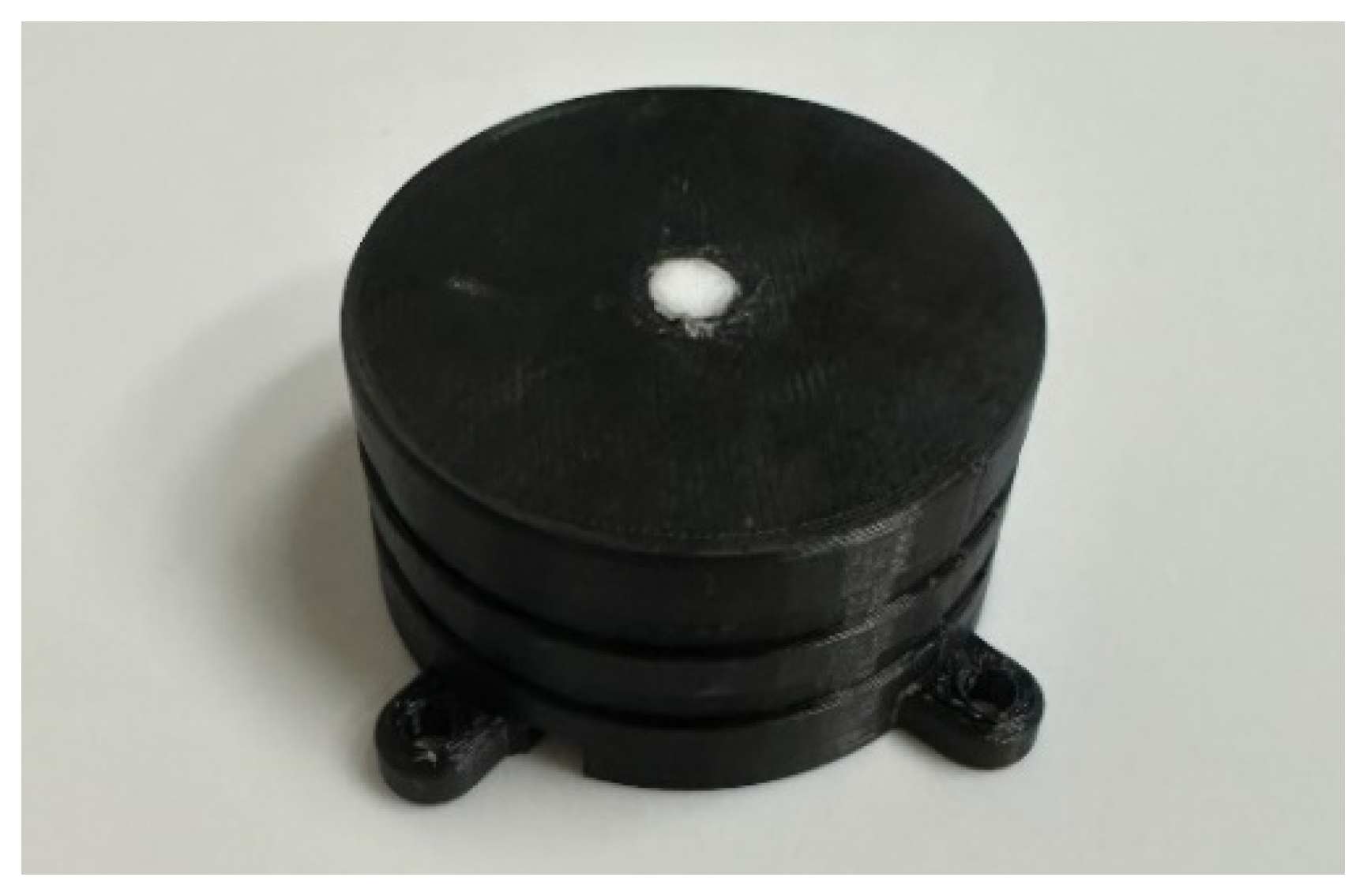
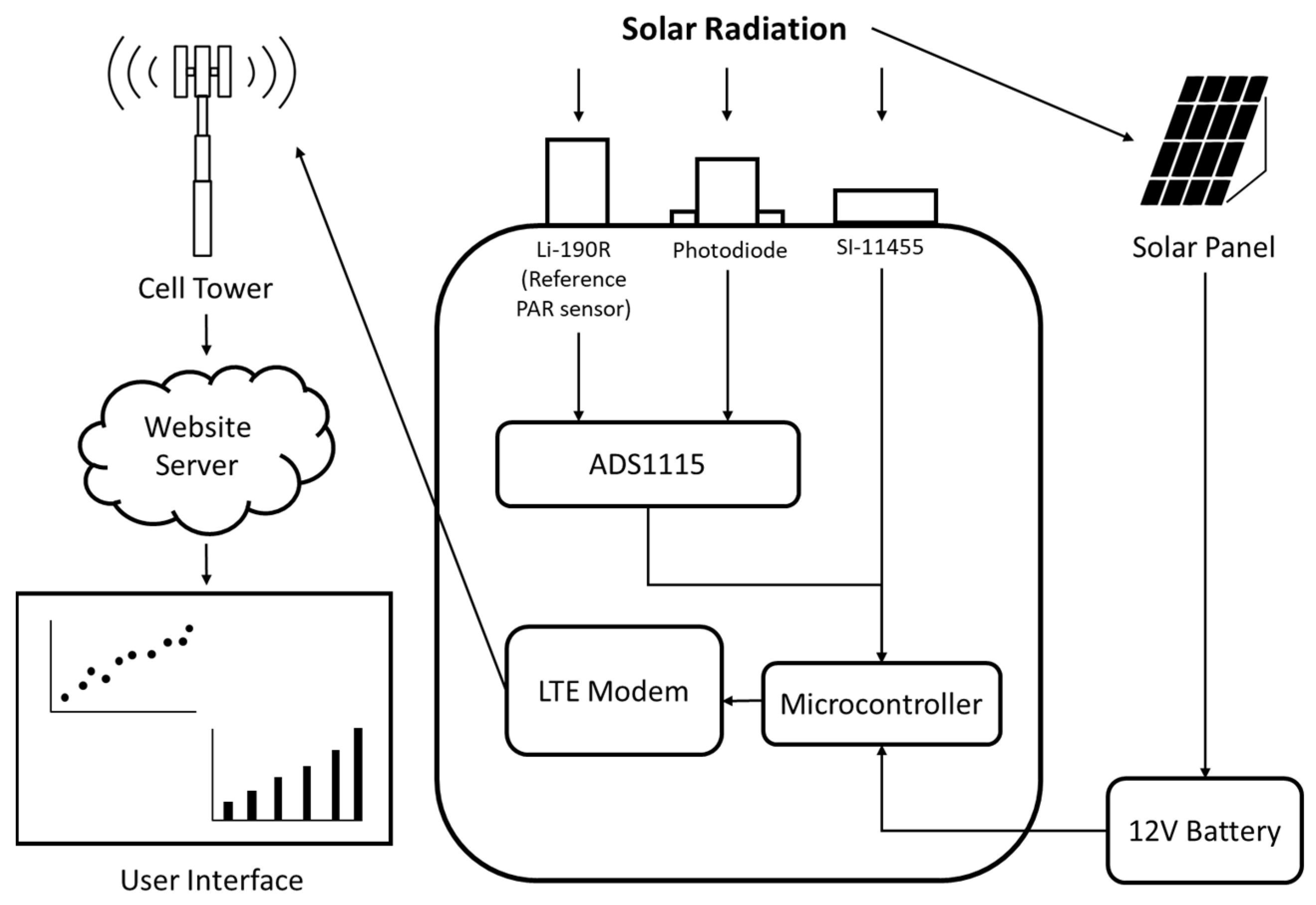

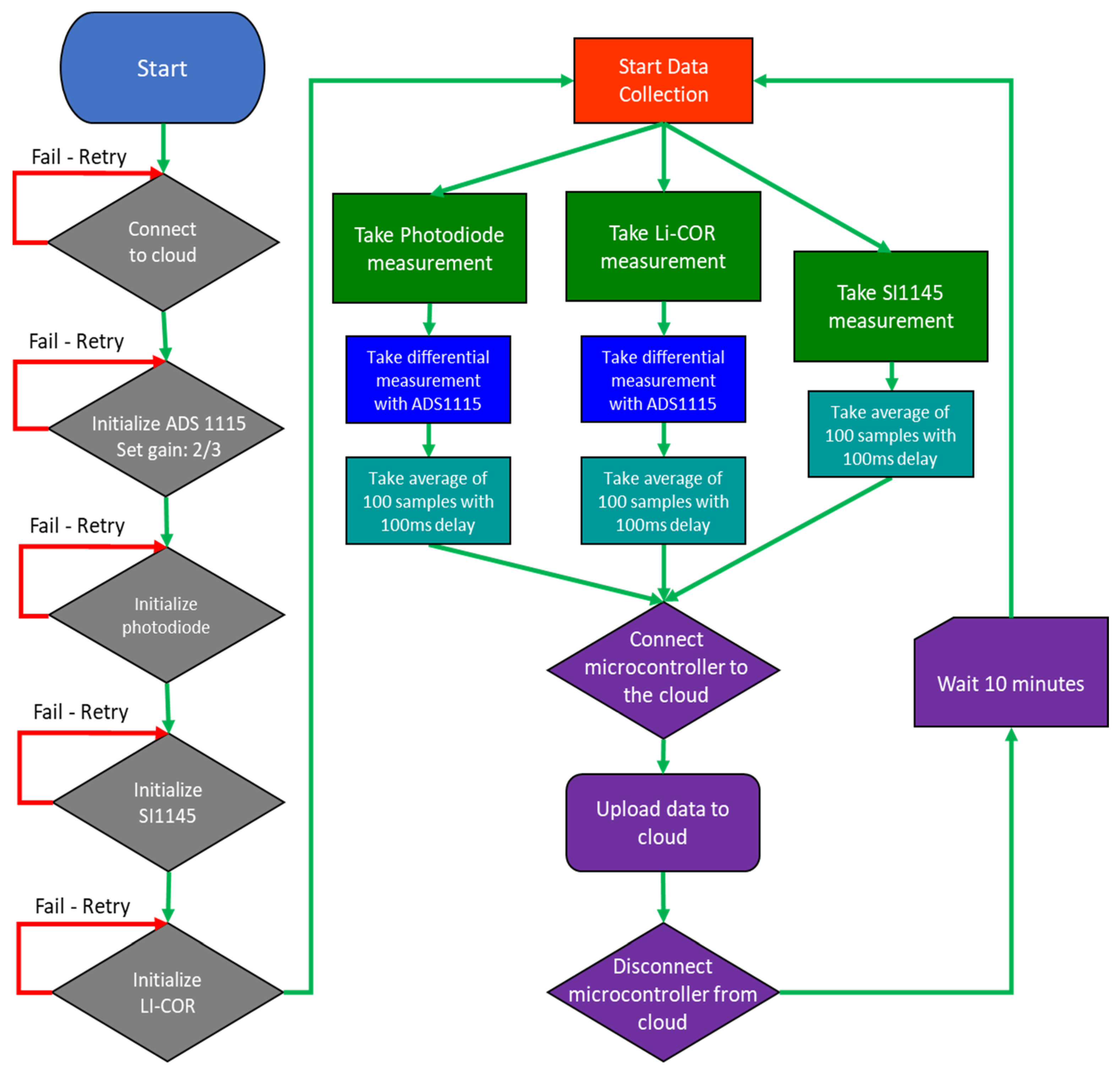
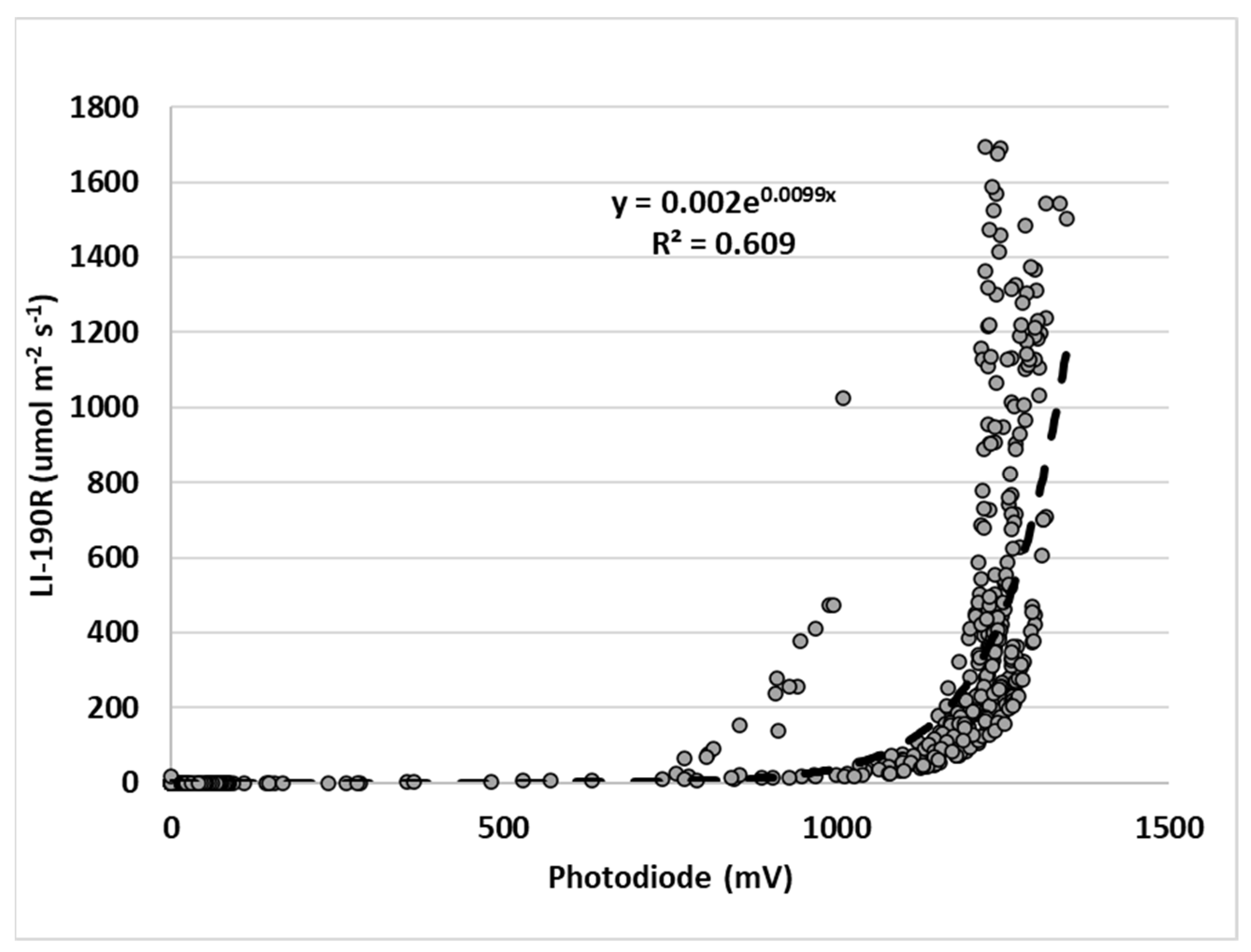
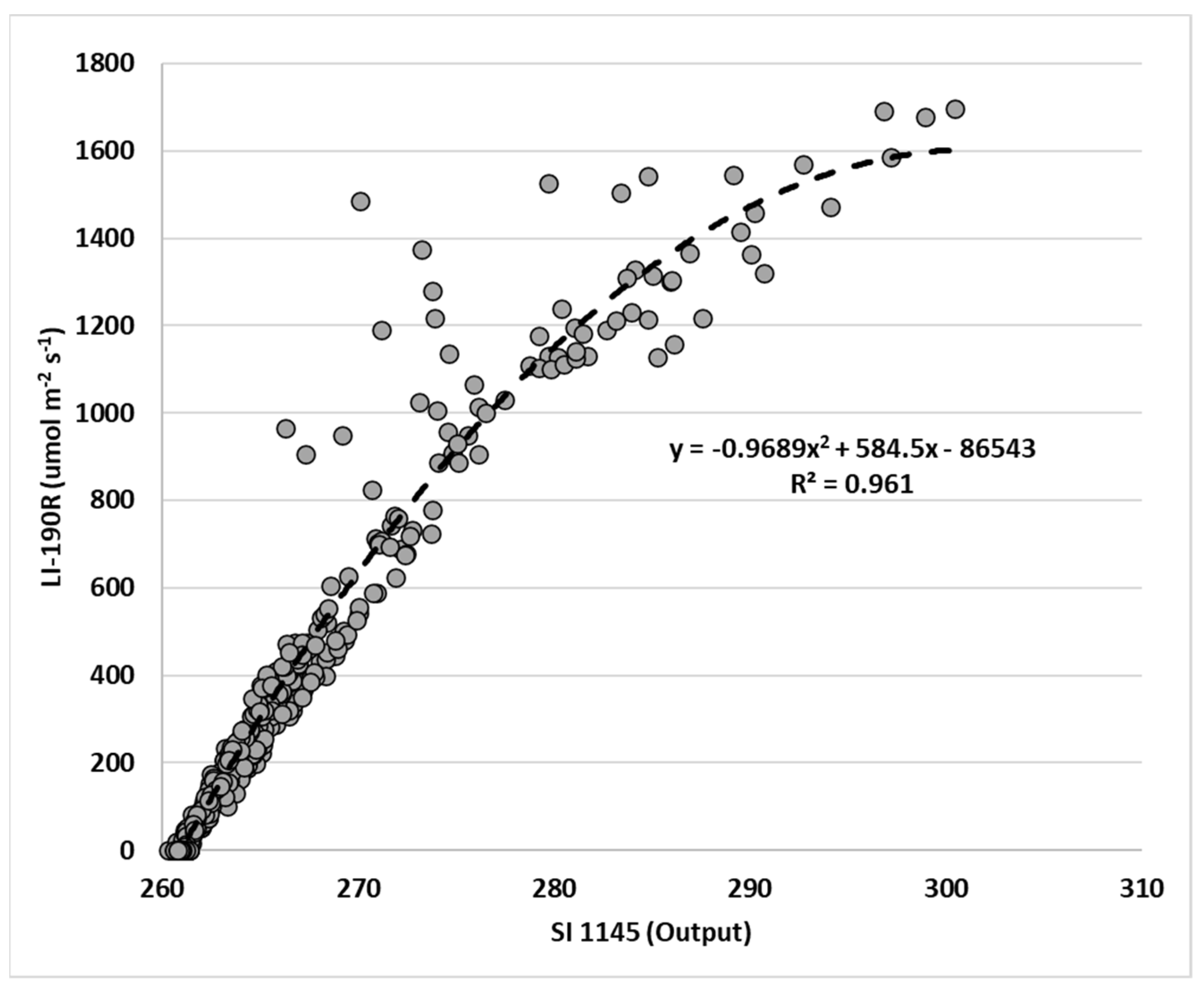
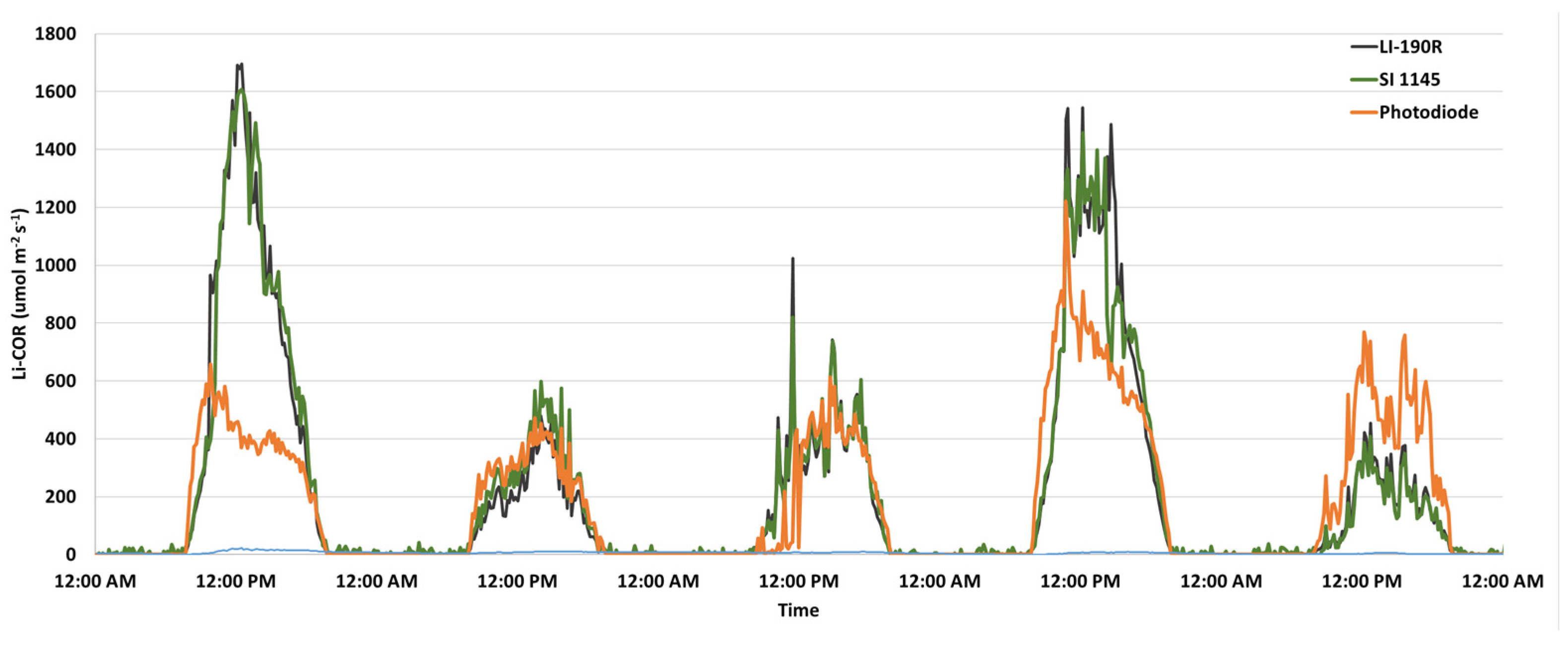
| Sensors | RMSE | IA | MBE |
|---|---|---|---|
| SI 1145 | 72.2 | 0.989 | 3.564 |
| Photodiode | 234.3 | 0.834 | −31.399 |
| Setup Component | Item | Quantity | Price (USD) |
|---|---|---|---|
| Power system | 25 W Solar Panel | 1 | 32.00 |
| Solar Charge Controller | 1 | 15.00 | |
| 12 V 7.2 Ah Battery | 1 | 10.00 | |
| Enclosure | 1 | 35.00 | |
| Total | 92.00 | ||
| LI-190R system | LI-190R | 1 | 470.00 |
| ADS 1115 | 1 | 14.95 | |
| Particle Boron | 1 | 65.31 | |
| Total | 550.26 | ||
| SI 1145 system | SI 1145 | 1 | 9.95 |
| Particle Boron | 1 | 65.31 | |
| UV AR IR Cut Glass Filter | 1 | 5.00 | |
| 2 × 250 × 250 mm PTFE Sheet | 1 | 27.00 | |
| ABS 3D-Printing Cost | 1 | 3.00 | |
| Total | 110.26 | ||
| Photodiode system | Photodiode (VTB8440BH) | 1 | 3.07 |
| ADS 1115 | 1 | 14.95 | |
| Particle Boron | 1 | 65.31 | |
| UV AR IR Cut Glass Filter | 1 | 5.00 | |
| 2 × 250 ×250 mm PTFE Sheet | 1 | 27.00 | |
| ABS 3D-Printing Cost | 1 | 3.00 | |
| Total | 115.26 |
Disclaimer/Publisher’s Note: The statements, opinions and data contained in all publications are solely those of the individual author(s) and contributor(s) and not of MDPI and/or the editor(s). MDPI and/or the editor(s) disclaim responsibility for any injury to people or property resulting from any ideas, methods, instructions or products referred to in the content. |
© 2024 by the authors. Licensee MDPI, Basel, Switzerland. This article is an open access article distributed under the terms and conditions of the Creative Commons Attribution (CC BY) license (https://creativecommons.org/licenses/by/4.0/).
Share and Cite
Dong, Y.; Hansen, H. Design of an Internet of Things (IoT)-Based Photosynthetically Active Radiation (PAR) Monitoring System. AgriEngineering 2024, 6, 773-785. https://doi.org/10.3390/agriengineering6010044
Dong Y, Hansen H. Design of an Internet of Things (IoT)-Based Photosynthetically Active Radiation (PAR) Monitoring System. AgriEngineering. 2024; 6(1):773-785. https://doi.org/10.3390/agriengineering6010044
Chicago/Turabian StyleDong, Younsuk, and Hunter Hansen. 2024. "Design of an Internet of Things (IoT)-Based Photosynthetically Active Radiation (PAR) Monitoring System" AgriEngineering 6, no. 1: 773-785. https://doi.org/10.3390/agriengineering6010044
APA StyleDong, Y., & Hansen, H. (2024). Design of an Internet of Things (IoT)-Based Photosynthetically Active Radiation (PAR) Monitoring System. AgriEngineering, 6(1), 773-785. https://doi.org/10.3390/agriengineering6010044







